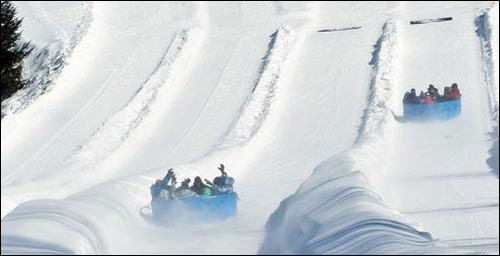Oct 29, 2014Glissades des Pays d'en Haut, a sledding and snow-tubing resort located in Quebec, Canada, is employing passive EPC ultrahigh-frequency (UHF) RFID tags to identify when the large, round multi-passenger "tornado" sleds head down the snow-covered slopes and reach the end of the trail. Operators of the six gates controlling the sleds' access to slopes are using this information to ensure there are no safety issues that could lead to one sled colliding with another. The RFID-based Line Control & Safety for Sledding solution was provided by Toronto technology firm GAO RFID.
The resort—located a 35-minute drive north of Montreal—offers visitors the opportunity to ride the plastic sleds at speeds of up to 80 kilometers per hour (50 miles per hour). To ensure that no more than one tornado is on the same trail at any given time, the gate operators carefully manage each sled's release, according to Mathieu Berthiaume, who worked for Glissades as a consultant on the RFID project. If a tornado travels much slower than expected or becomes stuck in the snow, operators could mistakenly believe that it had completed its run when, in fact, it had not, and consequently release the next sled, creating the potential for a collision. A tornado can accommodate up to eight people, and when fully loaded, it can weigh as much as a ton, so injuries resulting from such a collision could be significant. As such, the resort began seeking a system that would enable operators to know if they were about to release a sled too soon after another was sent down the slide.
In 2013, GAO RFID was awarded the contract for such a system, and had the task of installing RFID hardware able to sustain temperatures reaching below -40 degrees Celsius (-40 degrees Fahrenheit), as well as heavy winds and blowing snow. The company installed its GAO 236015 UHF RFID readers (made with an Impinj Speedway Revolution R420 reader with four antenna ports) and GAO 236018 UHF RFID readers (made with an Impinj Speedway Revolution R220 model with two antenna ports) at the trails' six access gates at the top of the slopes, as well as at the disembarking points at the bottom. The readers were selected due to their ability to operate under rugged conditions, says Frank Gao, the company's CEO. GAO RFID also attached an Omni-ID Max tag to the side of each tornado. The passive EPC Gen 2 tags can be interrogated at a distance of up to 10 meters (33 feet), even when whizzing by at speeds of up to 50 kilometers per hour (31 miles per hour).
When a sled passes through a gate at the top of the slope, a reader captures its tag's ID number, causing the system to automatically lock the gate so no other sled can access that trail. At the bottom of the slide, a second fixed reader captures the sled's tag ID, and the system informs the gate operator that it is now safe to release the next sled. The gate, which is hydraulically or electrically controlled, must still be activated by an operator, however, thereby providing redundancy, and thus an additional level of security. If an operator attempts to open a gate before the sled has completed its run and had its tag ID captured by a reader at the bottom of trail, the system will prevent the gate from unlocking. Glissades also installed cameras at the bottom of the slope, as well as video screens at the gates, so that an operator can visually verify that a sled is off the trail before opening the gate.
"Prior to installation of the RFID system, the resort tried using different technology," Berthiaume says. "They used, at first, a movement sensor to detect tornado sleds on slides. It worked part of the time, and there was no precision at all." The company also tried burying a metal plate at the end of each trail, with a metal sensor installed overhead to detect when a sled passed over the plate, but the snow made this option perform unreliably as well. Because snow conditions at the resort often change, he adds, the actual trails that the sleds travel down must be modified and moved, requiring that the underground metal plate and sensor be moved periodically—which proved inconvenient for the resort.
Berthiaume researched other technologies and came upon GAO RFID, which he says was the only company willing to carry out some collaborative development to create a solution that would work in the resort's snowy conditions. "RFID is great," he states, "because field coverage is precise and can be fine-tuned."
The resort tested the RFID solution for several months before deploying it in December 2013, at the beginning of the winter season. The technology not only helps control the gates' operation, Berthiaume reports, but also provides data that can be used by management. "We can know how many sleds are outside at the same time, which one is faster, where they are, and precisely when they are at the bottom."
The data could allow the company to better identify which sleds should be used, and how much time they require to travel down the slope. The information could also help the firm manage when additional sleds should be removed from storage and be brought to the slide.
"I don't think an automated system will ever replace an operator," Berthiaume says, "but it is a great tool for them." While it is ultimately still the operators' decision when to open or close gates, he notes, the RFID solution ensures that no mistakes are made. For instance, if a sled becomes stuck during descent, the system will keep the gate locked in the closed position, even if the operator does not realize it.


